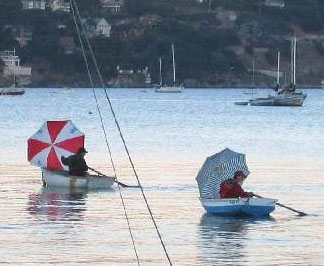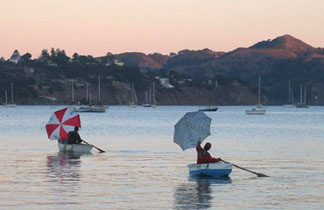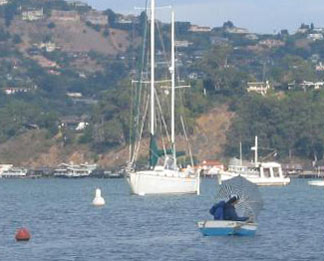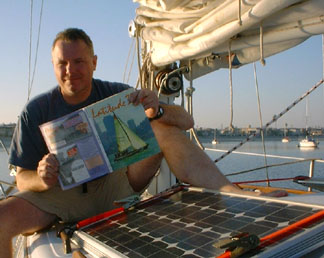A Whale of a Story
January 13 - Los Cabos, BCS
Petaluma Riverkeeper Dave Yearsley sent
us this story as a follow up to our Mexican drift net fishing
ban item, which appeared in yesterday's
'Lectronic. It comes from the national Waterkeepers Alliance
list.
Kevin Colter of Amigos Del Mar de Los Cabos
tells the story, "Saturday morning, January 10, we got word
from Solmar Sportfishing Fleet that a humpback whale was sighted
by one of their boats, struggling offshore of Chileno Bay, entangled
in a drift net. Sr. Luis Bulnes, the owner of Solmar Fleet urged
us to help free the doomed animal. So we from Amigos Del Mar
and TV reporter Armando Figaredo on board a fast Solmar fishing
boat provided by Sr. Bulnes, plus Oscar Ortiz and some folks
from Cabo Expeditions, Lieutenant Pino Salas and one of his divers
from the the Mexican Navy, and Oscar Hernandez and another diver
from the Deep Blue dive shop, headed out to try to help.
"When we arrived at Chileno Bay we
found the whale (a 40-ft female) completely entangled and wrapped
up in a monofilament net that was probably 70 feet long. The
net covered her whole body and trailed behind her. I thought
to myself there is no way we can do this! It was just too much
for our small group of amateurs. But we all decided to at
least give it a try.

This is the mass of fouled net the divers found on the whale.
"The divers entered the water and
swam toward the whale, Oscar from Cabo Expeditions hooked about
100 feet of line and a buoy to the net and we started to try
to pull ourselves down that line close to her. She was frightened
and moving along pretty good at this point, so pulling yourself
along was difficult. We would pull ourselves down the line then
grab onto the net, use the mesh of the net pull ourselves hand
over hand onto her body and pick a spot and start cutting. The
mono line of the net was very tough and you could only cut a
strand or two at a time. The unbreakable line cut into your hands
as you hung onto it, and many of us are sporting deep line cuts
on our palms and our fingers this morning. You would hold on
and cut until you simply didn't have the strength in your arms
to hold on any more, then you released yourself and floated to
the surface. As you rested for a minute the Zodiac boat from
Cabo Expeditions would come alongside, you would grab on and
they would tow you back to the trailing buoy and you started
the process all over again.
"Her mouth was completely wrapped
and sealed shut, her long pectoral fins were totally ensnared
against her body, and a huge wad of net was trailing down her
body and around her tail. For all that she sure could swim. We
were moving through the water so quickly at one point I turned
my head and my mask was pulled away from my face just from the
slipstream current she was creating.
"Myself and Lt. Salas, a really excellent
diver, ended up working together around her head. My theory was
that even if we couldn't get all the net, if we could just get
her head free at least she could feed. We kept cutting the monofilament
and peeling it back away from her head until her huge mouth was
free of net. We then worked our way back along her body, pulling
the net back, and began cutting our way through the lines that
ensnared her pectoral fins. It was right at this point that the
most amazing thing happened; she just stopped, whether from exhaustion
or because she finally understood we were trying to help. She
became very still and just floated, breathing through her blowhole
quietly on the surface while all of us continued to cut, cut,
cut.
"To add a little spice to this whole
adventure, the net itself was filled with a rotting mass of dead
tuna, and several times we saw largish sharks circling above
or behind us as we worked. I've never really been afraid of sharks;
I've often dove with many sharks around, but in proximity with
all the rotten fish, they made me a bit nervous. Oscar Ortiz
theorizes that the sharks, attracted by the whale's struggles,
were gathering, waiting for her to die so they could feed on
her.
"I was working in the area around
her eye when she actually began to 'sing' to us. As we worked,
the mournful song filled the water around us, and I could actually
feel it it vibrate deep in my body. Her singing motivated all
of us to work that much harder.

Colter and the whale swimming together, much of the net cleared
away
Photos Above Miguel Ortiz
"Once we had gotten most of the net
off her body, the remainder just tangled in her tail, the whale
took off, swimming fast trailing the whole length of net. I found
myself right next to Oscar at this point just hanging on; she
was swimming way too fast for us to even try to work on the remaining
net. Finally Oscar and I released from the line and floated to
the surface, all the other divers were already up; she had left
us all in the dust. We followed for a while, until she seemed
to settle down again and some of the guys went back to work.
I was completely spent. I floated quietly about 30 feet
away as Oscar Ortiz cut the last of the net free and the whole
tangled mess bobbed to the surface. Spectators who had assembled
around us in kayaks and small boats were cheering. Oscar came
to the surface waving his arms and screaming. She was free!

Kevin Colter and Lt. Salas with the mass of net, on the dock
at the navy base
Photo Don Hirschaut
"The net that nearly killed this wondrous
animal was what is called a 'drift gill net'. These nets are
terribly destructive, sweeping across a patch of ocean killing
everything in their path. Along with the food fish they are meant
to harvest, what's called by-catch, which to the fishing industry
means undesirable catch - the carcasses of sea lions, manta rays,
turtles and dolphins - are way too often found dead and rotting
in these nets. Drift net fishing has been banned in many parts
of the world because it is so destructive. Drift net fishing
persists here in Mexico, not, interestingly enough, to feed the
people of Mexico, but instead to provide fish for large chain
seafood restaurants in the U.S."
|









